Physical Address
304 North Cardinal St.
Dorchester Center, MA 02124
Age-related change in the muscles, tendons, ligaments, cartilages, and nerves that participate in pharyngeal function may alter swallowing dynamics, causing a swallowing disorder. The type of normal swallowing in young patients is found in only about 15% of people over age 80 years. , For example, loss of sensors at the palatoglossal isthmus and base of the tongue with aging results in poor bolus control at the palatoglossal isthmus with premature spill of the bolus into the oropharynx, poor timing between the oral and pharyngeal phases of swallowing, and subsequent laryngeal penetration. Sensory loss in the tongue and palate sensor is also manifested by loss of the gag reflex. These age-related changes are so common that laryngeal penetration is the expected “norm” in older patients, occurring in about 70% of people over age 80 years. ,
Stroke is the most common neurogenic cause of dysphagia. Any cerebrovascular disease from a large stroke to small vessel disease may affect varying portions of the swallowing pathways. Between 20% and 40% of patients with cerebrovascular accidents have dysphagia. , Patients with left cortical strokes have greater oral phase dysfunction and apraxia, whereas patients with right cortical strokes have greater laryngeal penetration and aspiration.
Any disease that affects the skeletal muscles of the head and neck or the nervous tissue in the swallowing pathway may cause dysphagia. These structures are discussed in detail in Chapter 4. Swallowing may be altered by central nervous system disease affecting the areas of the brain that participate in the ideation and movements of feeding. The cortical regions of the brain that participate in swallowing include the frontoparietal operculum of the motor cortex and the sensory postcentral gyrus (Broadman areas: 4/motor 6/premotor and sensory areas 3,2,1). Other areas, including the anterior insula, basal ganglia, and cerebellum, also participate in swallowing. Swallowing may also be affected by abnormalities in the corticobulbar pathways, motor and sensory portions of the brainstem swallowing center, V, VII, IX, X, XI, and XII cranial nerves, C1 and C2 roots, pharyngeal plexus, cervical ganglion, recurrent laryngeal nerve ( Fig. 5.1 ), and neuromuscular junctions.
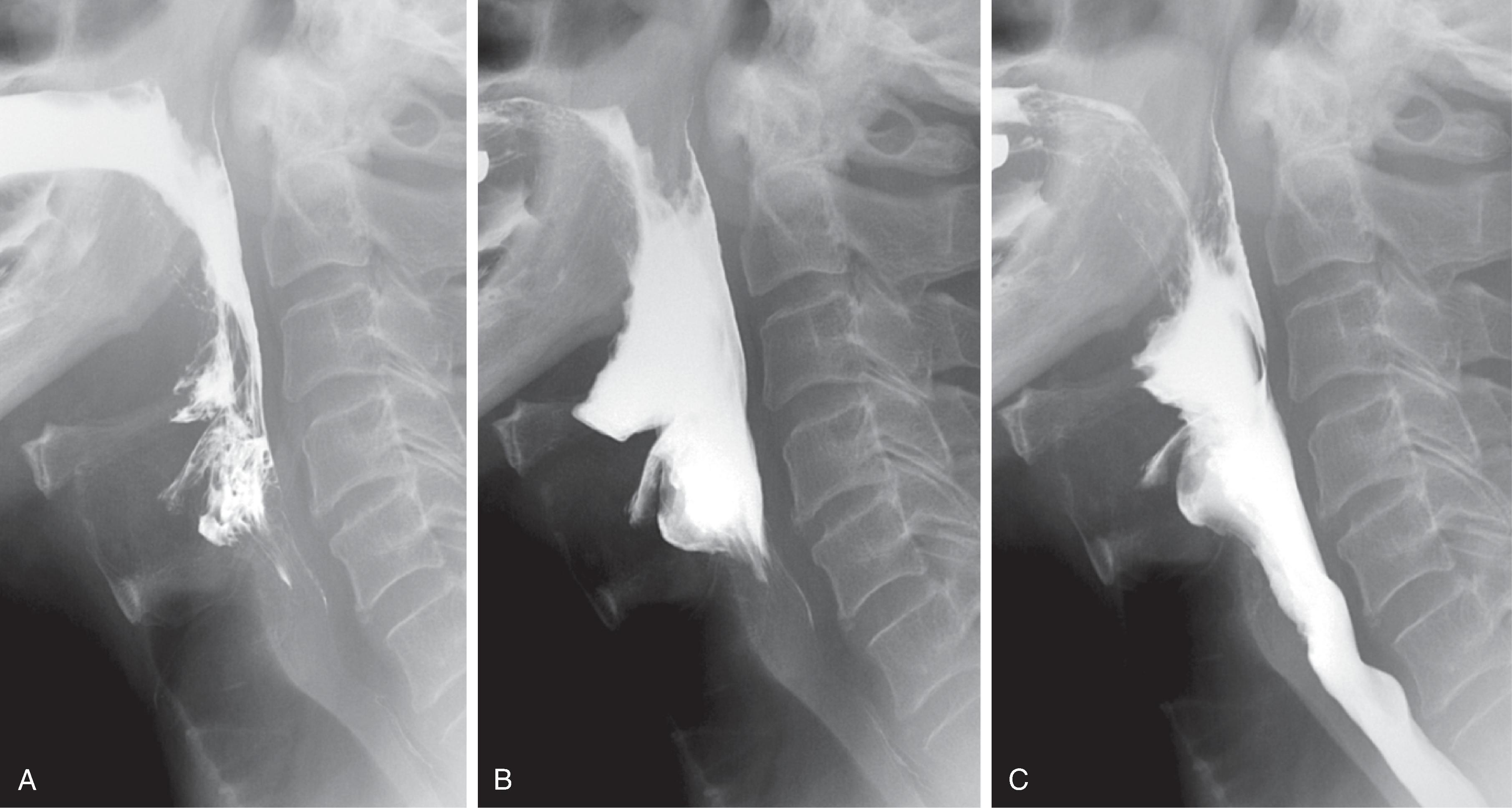
Lateral pharyngeal pouches may protrude beyond the normal expected contour of the lateral pharyngeal wall in areas unsupported by muscle layers. The upper anterolateral pharyngeal wall is particularly susceptible to the development of pouches and diverticula because it is poorly supported by the posterior portion of the thyrohyoid membrane. This region is bounded superiorly by the greater cornu of the hyoid bone, anteriorly by the thyrohyoid muscle, posteriorly by the superior cornu of the thyroid cartilage and stylopharyngeal muscle, and inferiorly by the ala of the thyroid cartilage.
Patients with lateral pharyngeal pouches usually have no symptoms. About 5% of people with lateral pharyngeal pouches complain of dysphagia, choking, or regurgitation of undigested food. , Lateral pharyngeal pouches are extremely common, and their frequency increases with age. These pouches are usually bilateral.
On frontal views during swallowing of barium, lateral pharyngeal pouches usually appear as transient, hemispheric, contrast-filled protrusions from the lateral hypopharyngeal wall below the hyoid bone and above the calcified edge of the thyroid cartilage ( Fig. 5.2 ). The junction of the ala of the thyroid cartilage and thyrohyoid membrane is seen on frontal views as a notch in the lateral pharyngeal wall. On frontal views in which a modified Valsalva maneuver is performed, the pouches are seen as hemispheric, barium-coated protrusions above this notch in the lateral pharyngeal wall. On lateral views, the pouches are seen as oval ring shadows or barium-filled sacs on the anterior pharyngeal wall below the hyoid bone at the level of the valleculae. , Barium retained in pouches during swallowing usually spills into the ipsilateral piriform sinus after the bolus passes.
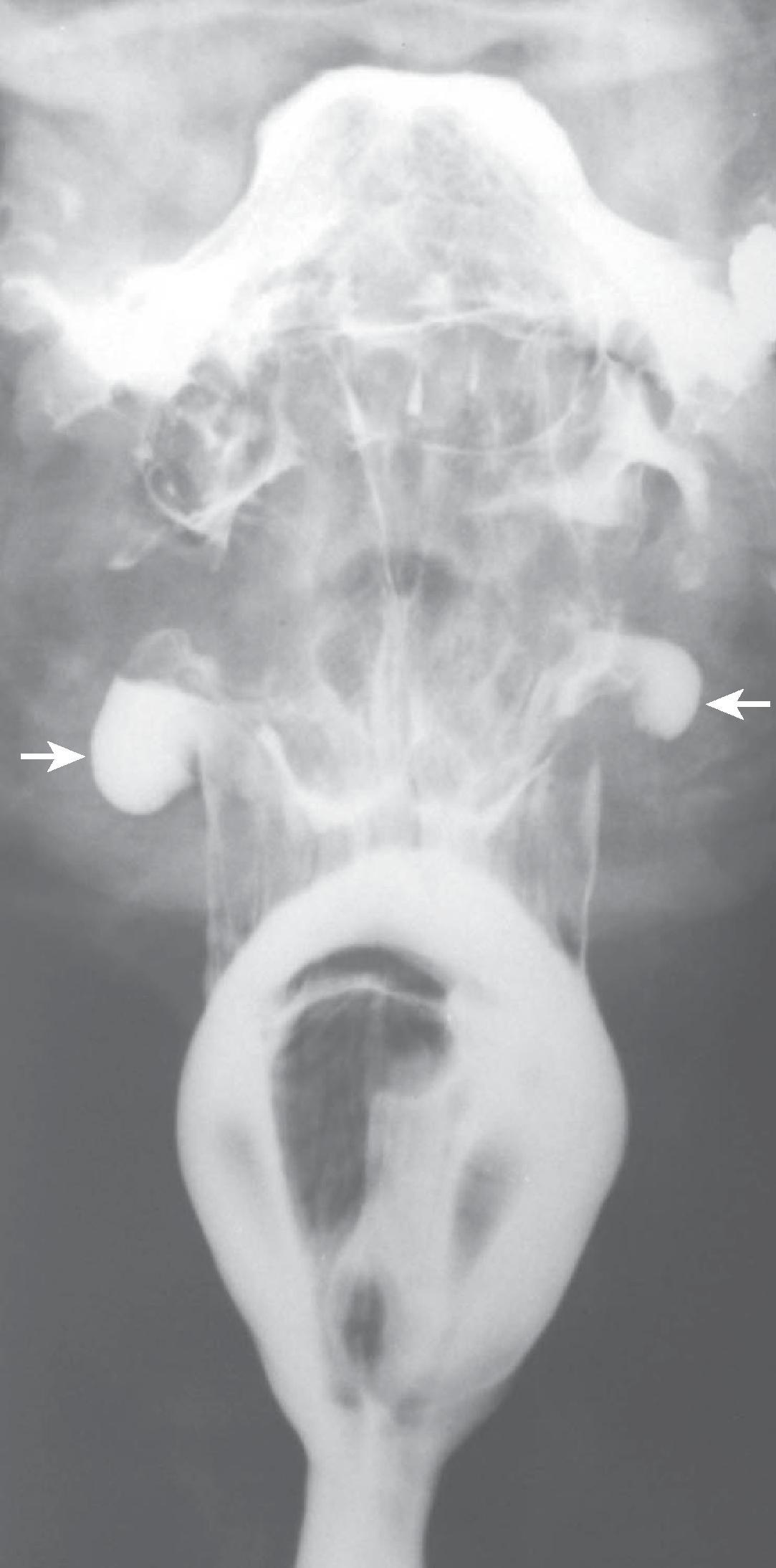
In contrast, lateral pharyngeal diverticula are persistent protrusions of pharyngeal mucosa, usually through the thyrohyoid membrane or, rarely, the tonsillar fossa. , The diverticula are lined by nonkeratinizing squamous epithelium surrounded by loose areolar connective tissue. These protrusions are commonly found in those who have increased intrapharyngeal pressure (e.g., wind instrument players and glass blowers). Clinical symptoms include dysphagia, choking, cough, hoarseness, regurgitation of undigested food, or a painless neck mass. , The diverticula appear on barium studies as persistent barium-filled sacs of various sizes connected to a bulging lateral hypopharyngeal wall by a narrow neck ( Fig. 5.3 ). Unlike pouches, lateral pharyngeal diverticula are usually unilateral.
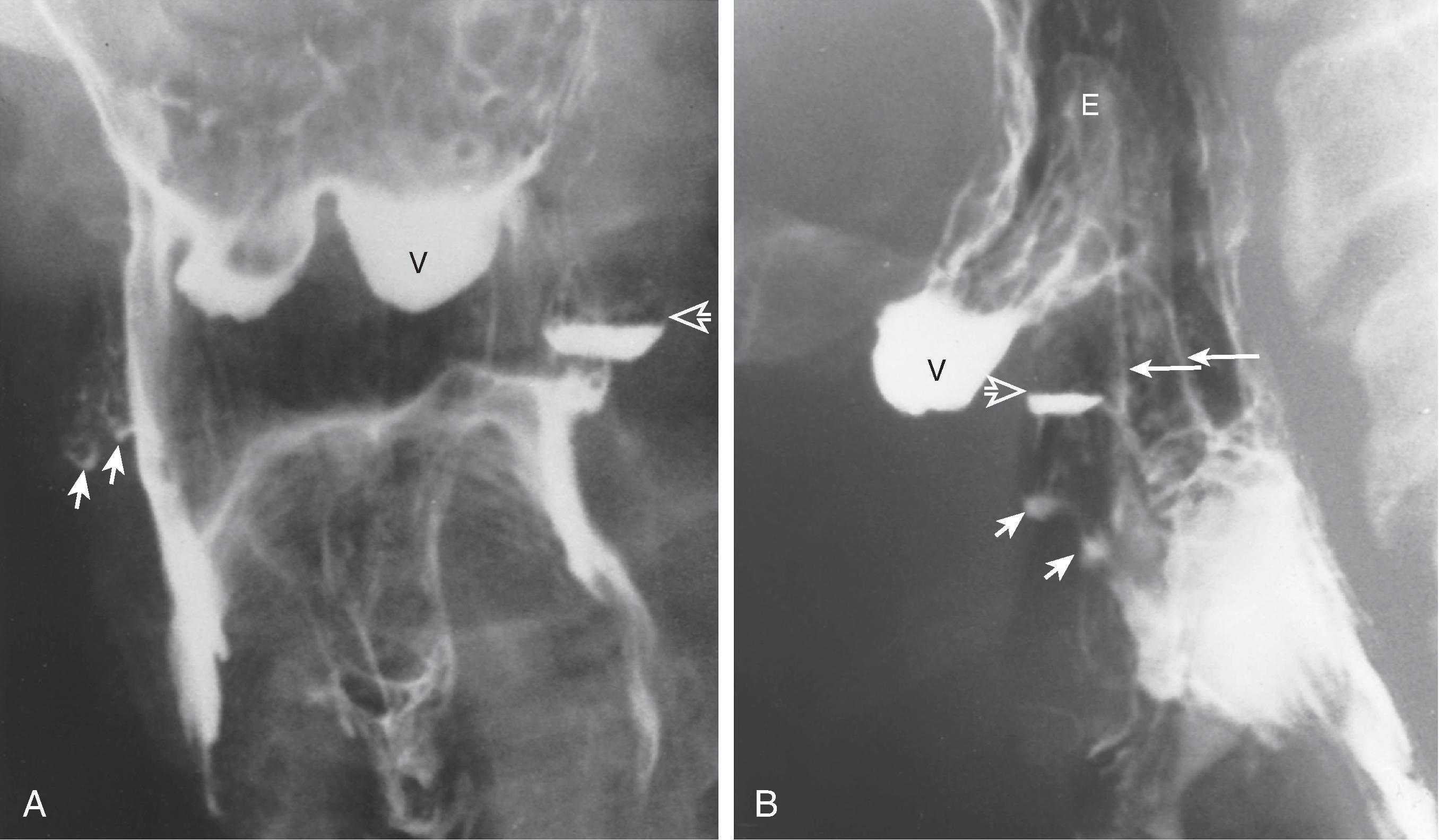
In the 4-week-old embryo, paired grooves of ectodermal origin, known as branchial clefts, appear on both sides of the neck. , Branchial ridges (arches) lie between the branchial clefts. Four outpouchings from the pharynx of endodermal origin, known as branchial pouches, then grow to meet these clefts. The first branchial cleft forms the external auditory meatus; the second branchial cleft forms the middle ear, eustachian tube, and floor of the tonsillar fossa; and the third and fourth branchial pouches form the piriform sinuses.
Persistence of these branchial pouches or clefts results in the formation of sinus tracts or cysts. The most common branchial vestige is a cyst arising from the second branchial cleft and is found at the level of the hyoid bone deep to the sternocleidomastoid muscle. Pathologically, these lesions are unilocular cysts lined by keratinizing, stratified, squamous epithelium and filled with desquamated keratinaceous debris.
Branchial pouch sinuses or fistulas are tracts that extend from the pharynx, ending blindly in the soft tissues of the neck as sinuses or continuing to the skin as fistulas. These tracts are lined by ciliated columnar epithelium. Branchial pouch sinuses arise from the tonsillar fossa (second pouch), upper anterolateral piriform fossa (third pouch), or lower anterolateral piriform sinus (fourth pouch) ( Fig. 5.4 ). Branchial pouch fistulas that communicate with the skin are often present at birth, whereas branchial pouch sinuses that terminate as blind-ending tracks are occasionally found in adults.
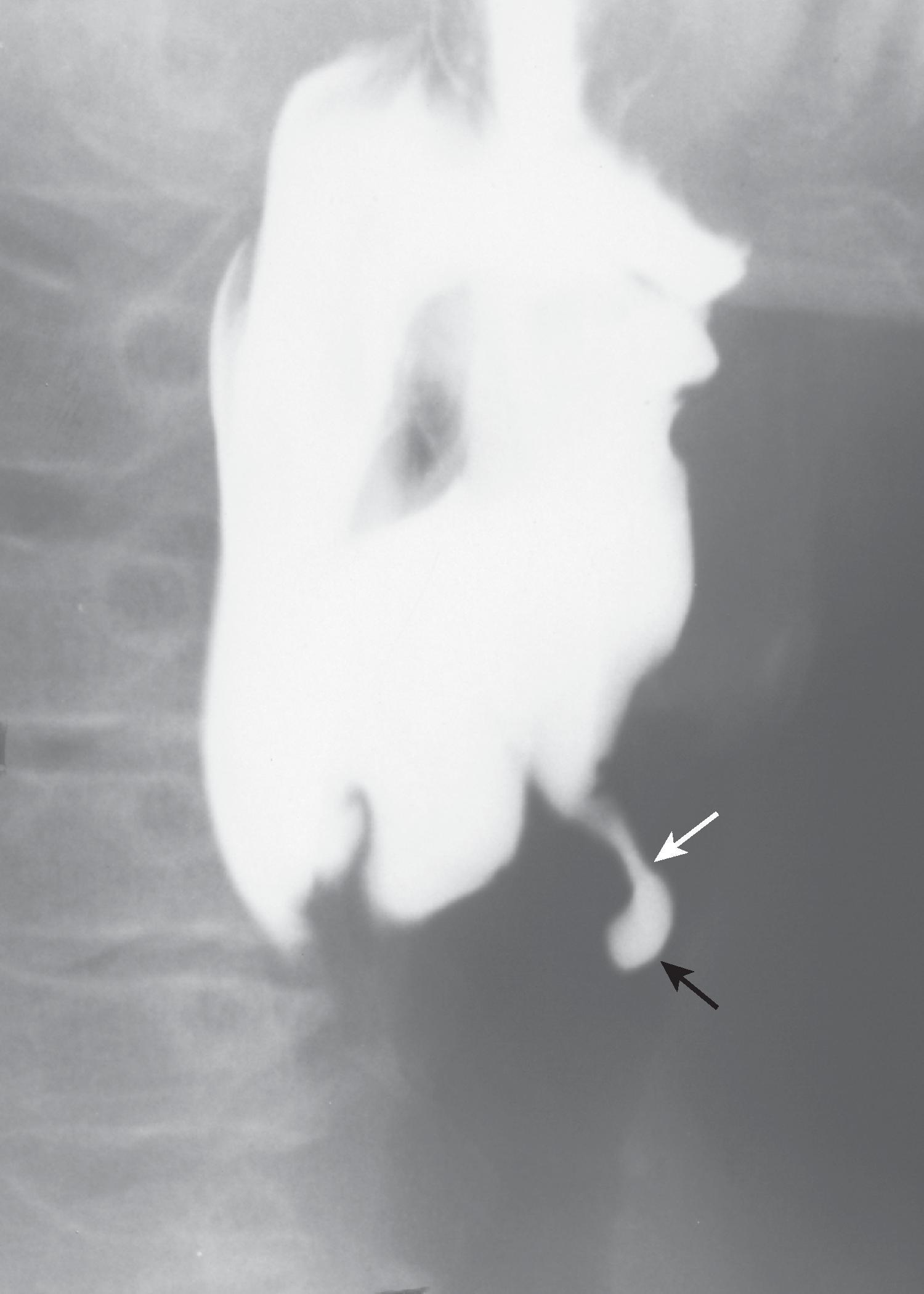
Zenker’s diverticulum (posterior hypopharyngeal diverticulum) is an acquired mucosal herniation through an area of anatomic weakness in the region of the cricopharyngeal muscle (Killian’s dehiscence). The thyropharyngeal muscle arises from the lateral ala of the thyroid cartilage; it courses laterally and posteriorly to merge with its counterpart from the opposite side in a raphe on the posterior pharyngeal wall. The cricopharyngeal muscle arises from the lateral cricoid cartilage to encircle the lowermost hypopharynx. The cricopharyngeal muscle has no midline raphe. No overlap of fibers exists between the thyropharyngeal and cricopharyngeal muscles. Considerable variation is found in the arrangement of the muscle bundles of the thyropharyngeal and cricopharyngeal muscles. Killian’s dehiscence is an area of weakness between the thyropharyngeal and cricopharyngeal muscles or between the oblique and horizontal fibers of the cricopharyngeal muscle found in about one third of patients. ,
The pathogenesis of Zenker’s diverticulum is controversial. Some radiographic and manometric studies have suggested that elevated pressures in the upper esophageal sphincter (UES) or incoordination and abnormal relaxation (achalasia) of the UES are contributing factors. However, other manometric studies have shown the following: (1) there is normal coordination between pharyngeal contraction and relaxation of the UES; (2) the UES relaxes completely during swallowing (i.e., there is no achalasia of the UES); and (3) the resting pressure of the UES is low (i.e., there is no spasm). , The relationship between gastroesophageal reflux (GER) and Zenker’s diverticulum is also controversial. Almost all patients with Zenker’s diverticulum have an associated hiatal hernia , and many patients have radiographic findings of GER, reflux esophagitis, or both. Whether gastroesophageal reflux disease (GERD) predisposes patients with a large Killian’s dehiscence to the formation of Zenker’s diverticulum is unknown.
Zenker’s diverticulum is usually found in older patients who have dysphagia, regurgitation of undigested food, halitosis, choking, hoarseness, or a neck mass. Some patients with Zenker’s diverticulum are asymptomatic.
During swallowing of barium, Zenker’s diverticulum is manifested on lateral views by posterior bulging of the lowermost hypopharyngeal wall above an anteriorly protruding pharyngoesophageal segment (cricopharyngeal muscle). The neck of Zenker’s diverticulum can be very broad during swallowing. At rest, the barium-filled diverticulum extends below the level of the cricopharyngeal muscle posterior to the proximal cervical esophagus ( Fig. 5.5 ). After swallowing, barium retained in the diverticulum is regurgitated into the hypopharynx, sometimes resulting in overflow aspiration.
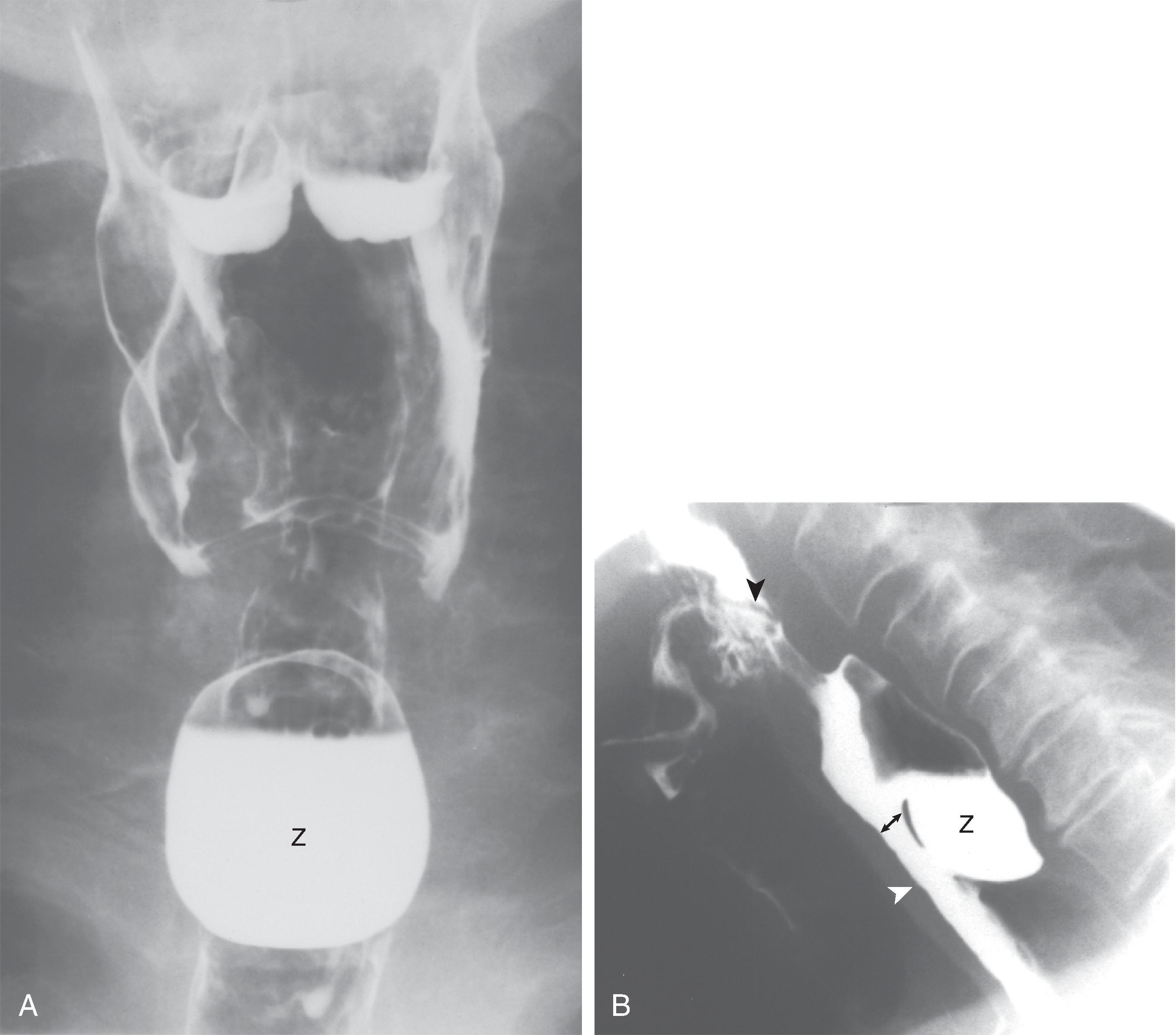
A true Zenker’s diverticulum may be confused with barium trapped above a cricopharyngeal muscle that has closed before the pharyngeal contraction wave has passed. This barium trapped between the downwardly progressing pharyngeal contraction and cricopharyngeal muscle is known as a pseudo-Zenker’s diverticulum ( Fig. 5.6 ). Barium may also be transiently retained above a region of early closure in the upper cervical esophagus. Incomplete opening and early closure of the cricopharyngeal muscle and early closure of the upper cervical esophagus are associated with GERD.
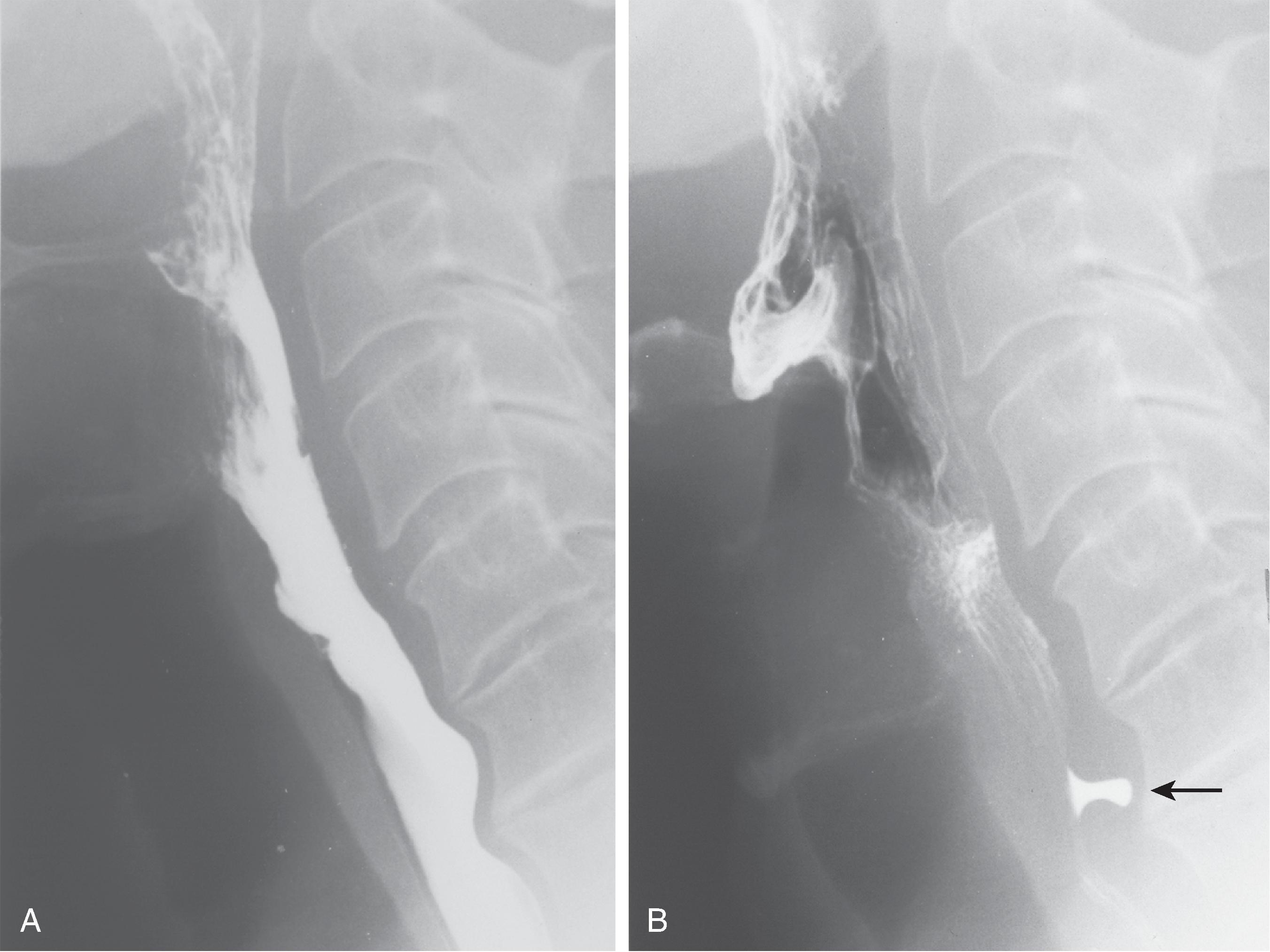
Complications of Zenker’s diverticulum include bronchitis, bronchiectasis, lung abscess, diverticulitis, ulceration, fistula formation, and carcinoma. Any change in the character of dysphagia or bloody discharge in a patient known to have Zenker’s diverticulum should suggest a complication. On barium studies, irregularity of the contour of Zenker’s diverticulum should suggest an inflammatory or neoplastic complication. Carcinoma arises in less than 1% of patients with Zenker’s diverticulum, but it is usually fatal.
The Killian-Jamieson space is a triangular area of weakness in the cervical esophagus just below the cricopharyngeal muscle. This space is bounded superiorly by the inferior margin of the cricopharyngeal muscle, anteriorly by the inferior margin of the cricoid cartilage, and inferomedially by the suspensory ligament of the esophagus originating from the posterior wall of the cricoid cartilage. ,
Transient or persistent protrusions of the anterolateral cervical esophagus into the Killian-Jamieson space are known as lateral cervical esophageal pouches or diverticula, respectively. They are also known as Killian-Jamieson pouches or diverticula . Most patients with Killian-Jamieson diverticula are asymptomatic, but some complain of dysphagia or regurgitation.
These pouches and diverticula are relatively common and may be confused on barium studies with Zenker’s diverticulum. Killian-Jamieson diverticula can be bilateral or unilateral. If unilateral, the diverticula are usually found on the left side of the proximal cervical esophagus. These structures are manifested on barium studies by a small (3–20 mm in diameter), round to ovoid, smooth-surfaced outpouching just below the cricopharyngeal muscle ( Fig. 5.7 ). On frontal views, the pouches appear as small, round or ovoid protrusions from the lateral upper esophageal wall that fill late during swallowing and then empty after swallowing. Diverticula appear on frontal views as saccular protrusions with narrow necks (see Fig. 5.7A ) that do not empty as quickly as pouches after swallowing. On lateral views, the anterior wall of the sac is anterior to the cervical esophagus below the level of the cricopharyngeal muscle. In contrast, the neck of Zenker’s diverticulum is on the posterior hypopharyngeal wall, and the sac extends inferiorly behind the cervical esophagus.
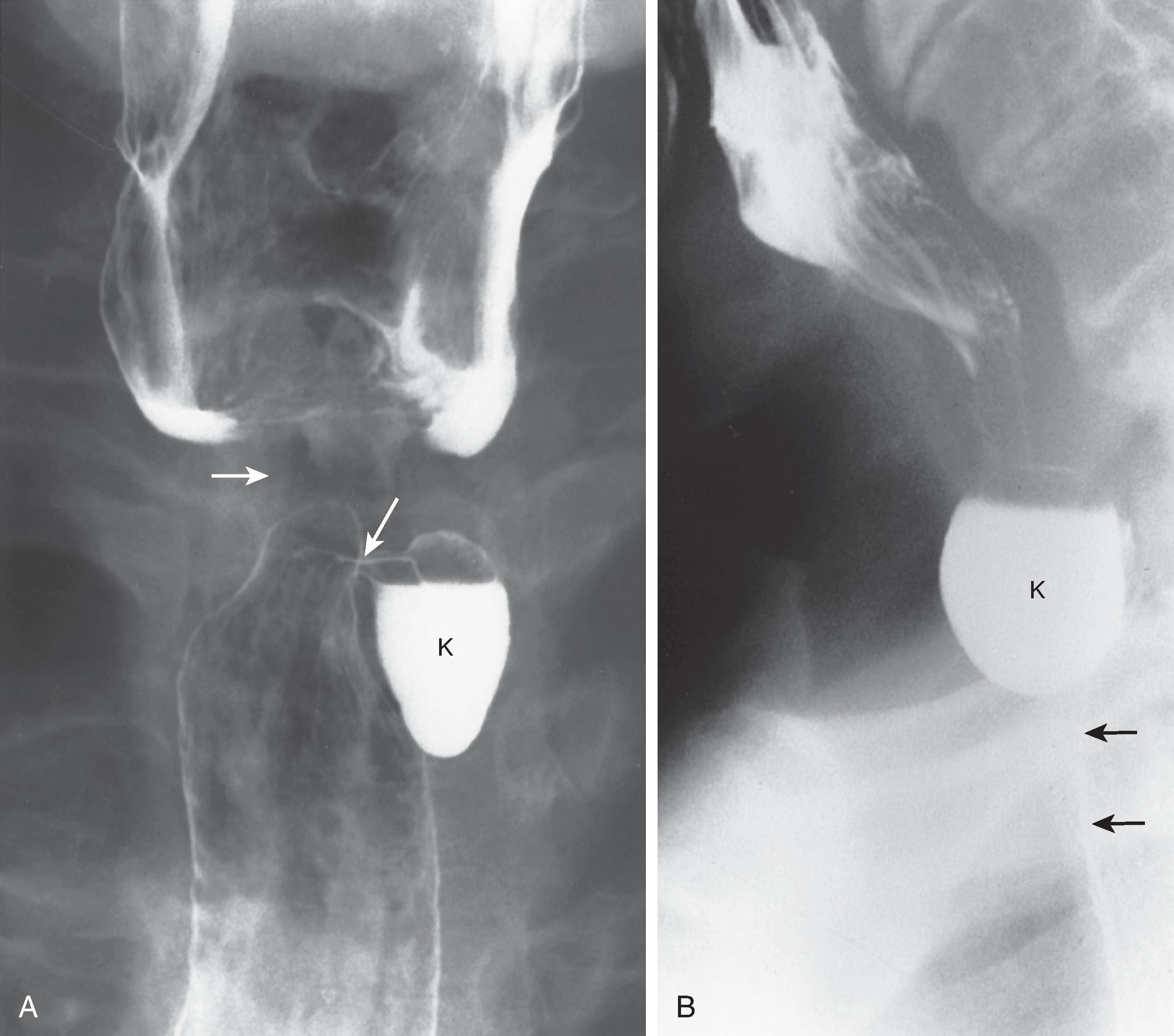
Webs are thin mucosal folds usually located along the anterior wall of the lower hypopharynx and proximal cervical esophagus. They are typically composed of normal epithelium and lamina propria, , and some webs show inflammatory changes. Most patients with cervical esophageal webs are asymptomatic, but some have solid food dysphagia.
Pharyngeal and cervical esophageal webs are sometimes associated with diseases that cause inflammation and scarring, such as epidermolysis bullosa and benign mucous membrane pemphigoid. Several older studies from northern Europe reported an association between cervical esophageal webs, iron-deficiency anemia, and pharyngeal or esophageal carcinoma. This association was called Plummer-Vinson syndrome or Paterson-Kelly syndrome. However, this association has not been found in the United States. Webs in the distal esophagus and some webs in the cervical esophagus may be associated with GERD. ,
Webs are sometimes seen in the valleculae or lower piriform sinuses. Such vallecular and piriform sinus webs are composed of mucosa and lamina propria and are thought to occur as normal variants.
Webs appear radiographically as 1- to 2-mm wide, shelf-like filling defects along the anterior wall of the hypopharynx or cervical esophagus ( Fig. 5.8 ). The webs protrude to various depths into the esophageal lumen. They may extend laterally, and a few extend circumferentially, appearing as ringlike shelves in the cervical esophagus. Webs associated with severe luminal narrowing (particularly circumferential webs) may cause dysphagia. Partial obstruction is suggested by a jet phenomenon or by dilation of the esophagus or pharynx proximal to the web (see Fig. 5.8 ). A dynamic examination reveals a higher percentage of webs than spot images alone. Webs are also better shown by the use of large boluses of barium.
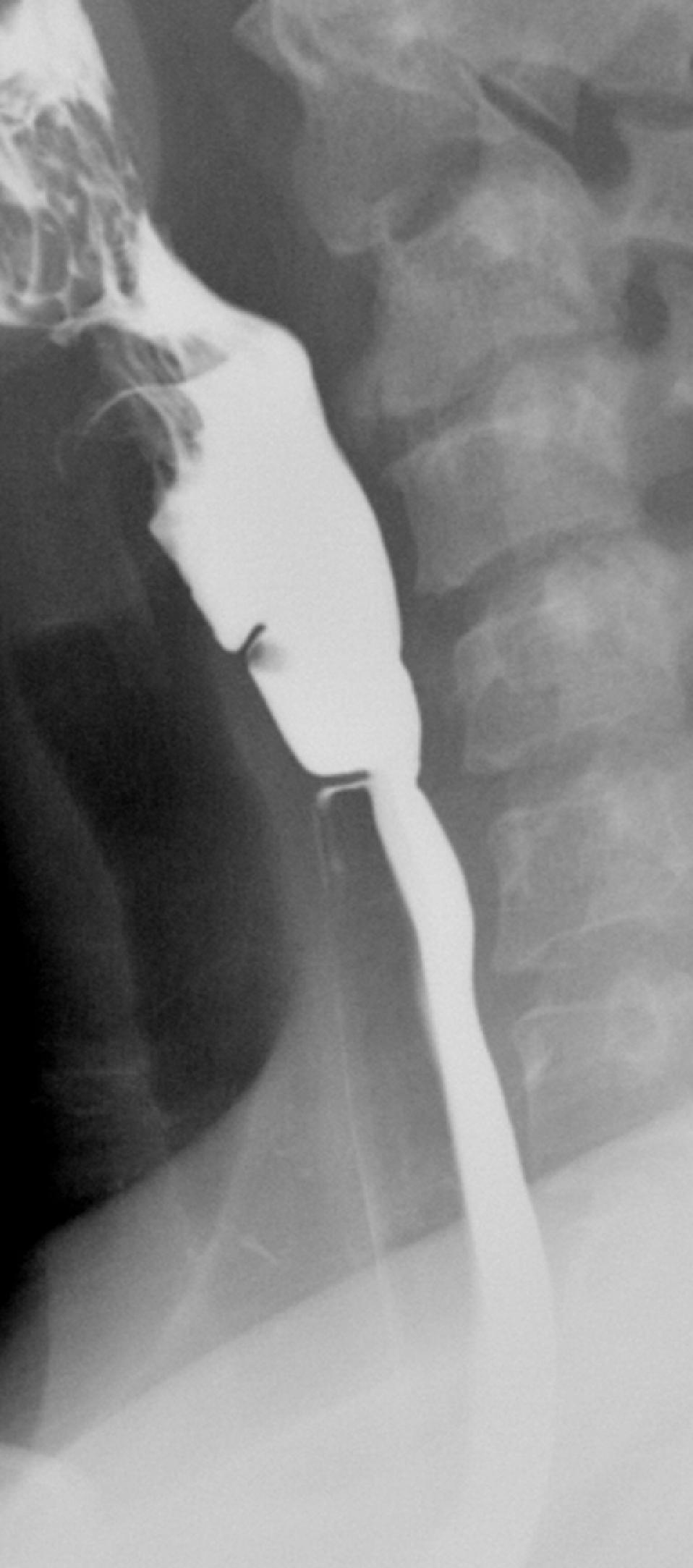
Webs may be confused on barium studies with an undulating anterior wall of the pharyngoesophageal segment at the level of the cricoid cartilage. This redundant mucosa has been called the postcricoid defect and is related to redundancy of mucosal and submucosal tissue in this region. Webs also should not be confused with a prominent cricopharyngeal muscle, which appears as a round, broad-based protrusion from the posterior pharyngeal wall at the level of the pharyngoesophageal segment.
Although acute epiglottitis usually affects children between 3 and 6 years of age, it occasionally causes severe stridor and sore throat in adults. Plain radiographic diagnosis of acute epiglottitis is important (even in adults) because manipulation of the tongue or pharynx may exacerbate edema and respiratory distress. Neck radiographs may show smooth enlargement of the epiglottis and aryepiglottic folds. Barium studies are contraindicated because they may exacerbate edema, triggering an episode of acute respiratory arrest.
Barium studies of the pharynx are usually of limited value in patients with acute sore throat caused by viral, bacterial, or fungal infection. Pharyngograms may reveal normal findings or nonspecific lymphoid hyperplasia of the lingual or palatine tonsils.
In immunosuppressed patients with acute dysphagia, barium studies are focused primarily on the detection of infectious esophagitis. However, double-contrast examination of the pharynx may show the plaques of Candida pharyngitis or the ulcers of herpes pharyngitis, particularly in patients with AIDS ( Fig. 5.9 ).
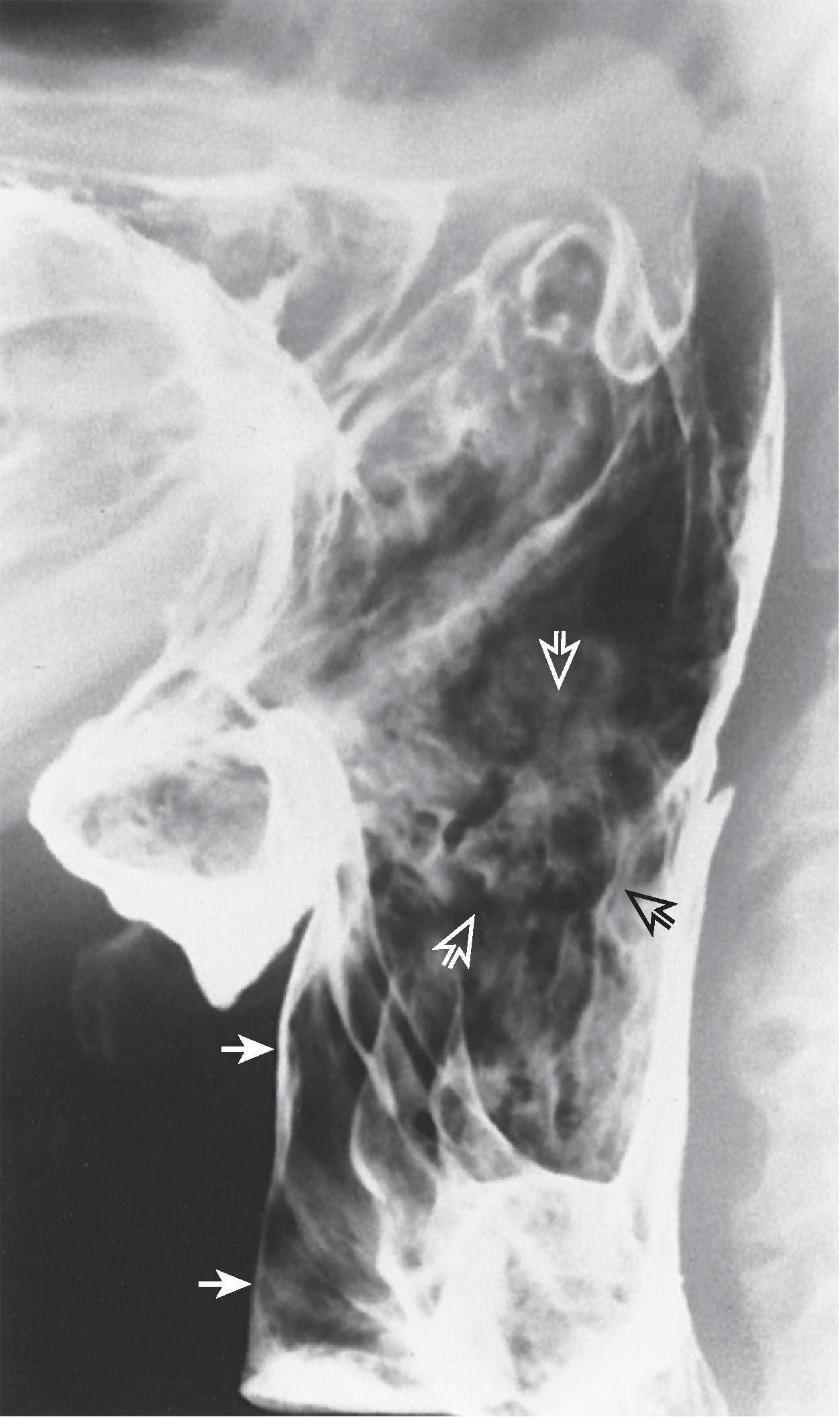
In patients with chronic sore throat, barium studies may help determine whether underlying GER and reflux esophagitis are present. Inflammatory disorders of the pharynx or GER can alter pharyngeal elevation, epiglottic tilt, or closure of the vocal cords and laryngeal vestibule, leading to laryngeal penetration or aspiration.
Some diseases associated with diffuse ulceration of mucous membranes may affect the pharynx. Pharyngeal inflammation and ulceration is sometimes seen in patients with Behçet’s syndrome, Stevens-Johnson syndrome, Reiter’s syndrome, epidermolysis bullosa, and bullous pemphigoid. Most of these patients have recurrent aphthous stomatitis and oropharyngeal ulceration. With severe ulceration, amputation of the uvula and tip of the epiglottis may be observed radiographically. Scarring may cause distortion of the pharyngeal contours. Severe pharyngeal ulceration and scarring may also be caused by lye ingestion ( Fig. 5.10 ).
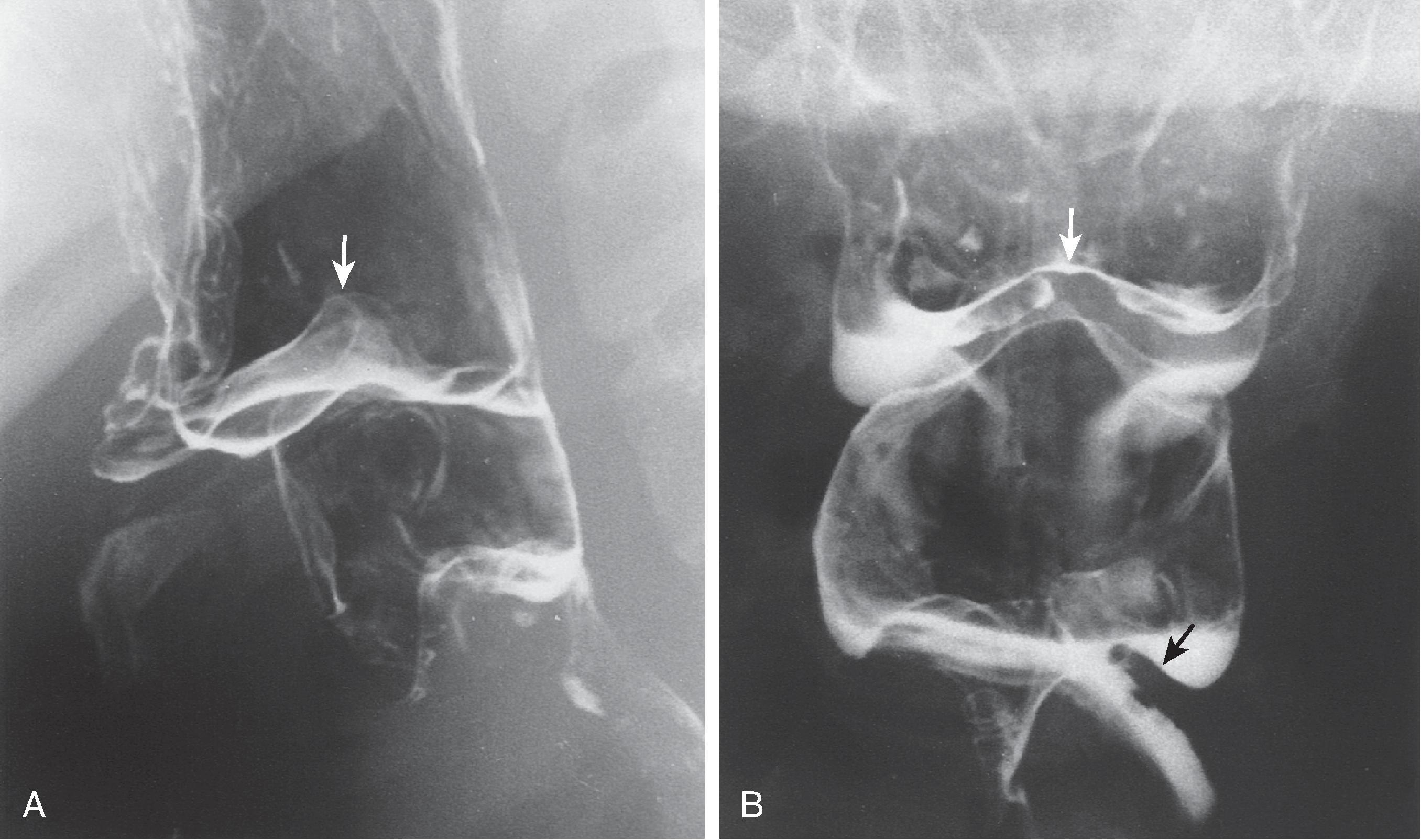
The lingual tonsil is an aggregate of 30 to 100 follicles along the pharyngeal surface of the tongue, extending from the circumvallate papillae to the root of the epiglottis. This lymphoid tissue is characterized by small nodules of varying size on the base of the tongue.
Hypertrophy of the lingual tonsil often occurs as a normal finding after puberty, as a compensatory response after tonsillectomy, or as a nonspecific response to allergies or repeated infection. Symptoms attributed to lymphoid hyperplasia of the lingual tonsil include throat discomfort, a globus sensation, and dysphagia. There are no criteria based on size for differentiating nodularity of the base of the tongue caused by normal lingual tonsils from that caused by reactive lymphoid hyperplasia. Lymphoid hyperplasia is characterized on frontal views by multiple smooth, round or ovoid nodules symmetrically distributed over the base of the tongue ( Fig. 5.11 ). The base of the tongue may seem to protrude posteriorly and may have an irregular contour on lateral views. With severe lymphoid hyperplasia of the tongue base, the nodules may extend into the valleculae, along the lingual surface of the epiglottis, or even into the upper hypopharynx. Although lymphoid hyperplasia of the lingual tonsil may be coarsely nodular, asymmetrically distributed, or masslike, the latter findings should be viewed with suspicion. In such cases, endoscopy and magnetic resonance imaging (MRI) may be helpful for excluding malignant tumor.
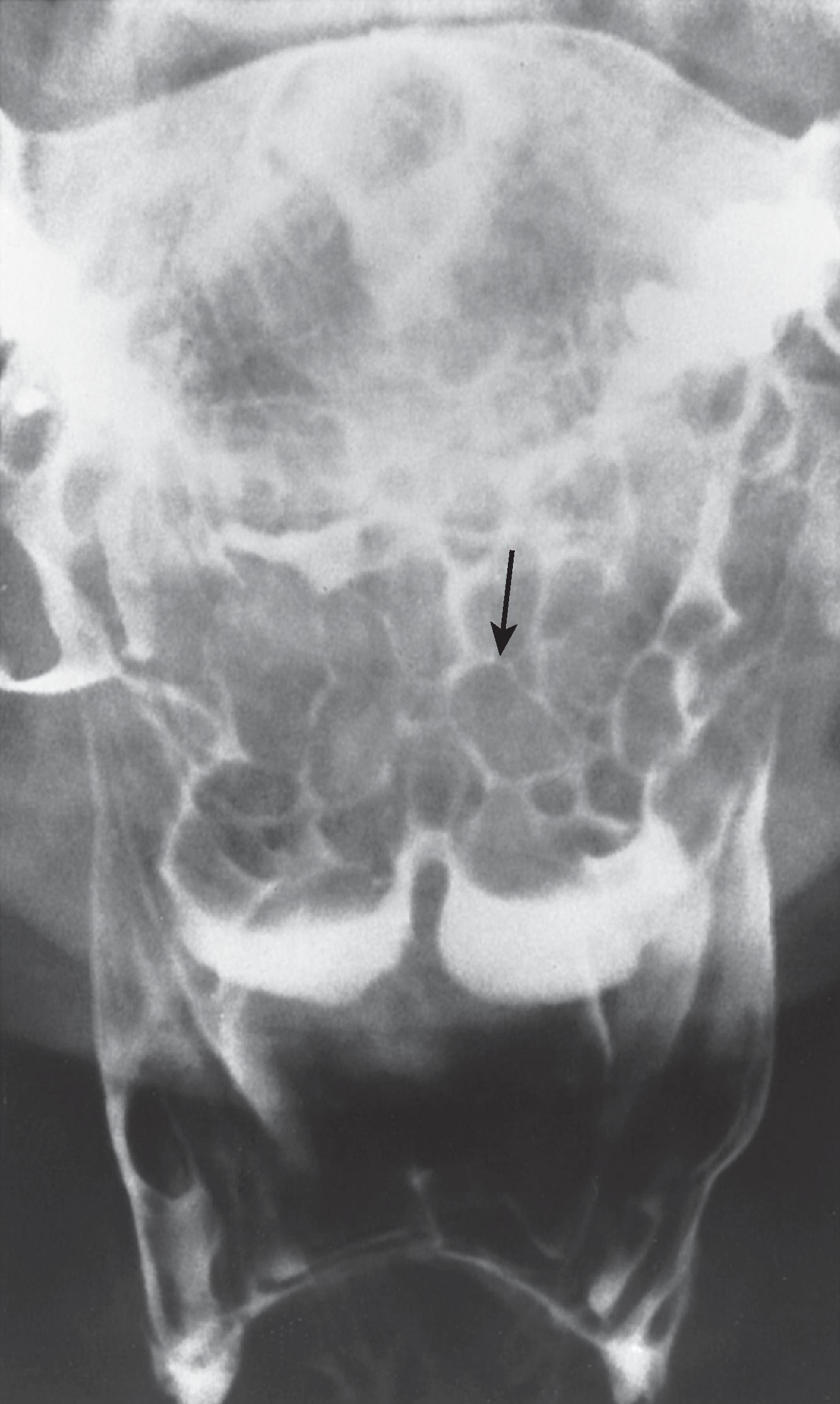
In contrast, lymphoid hyperplasia of the palatine tonsils is characterized by symmetric masslike enlargement of the palatine tonsils on frontal and lateral views ( Fig. 5.12 ).
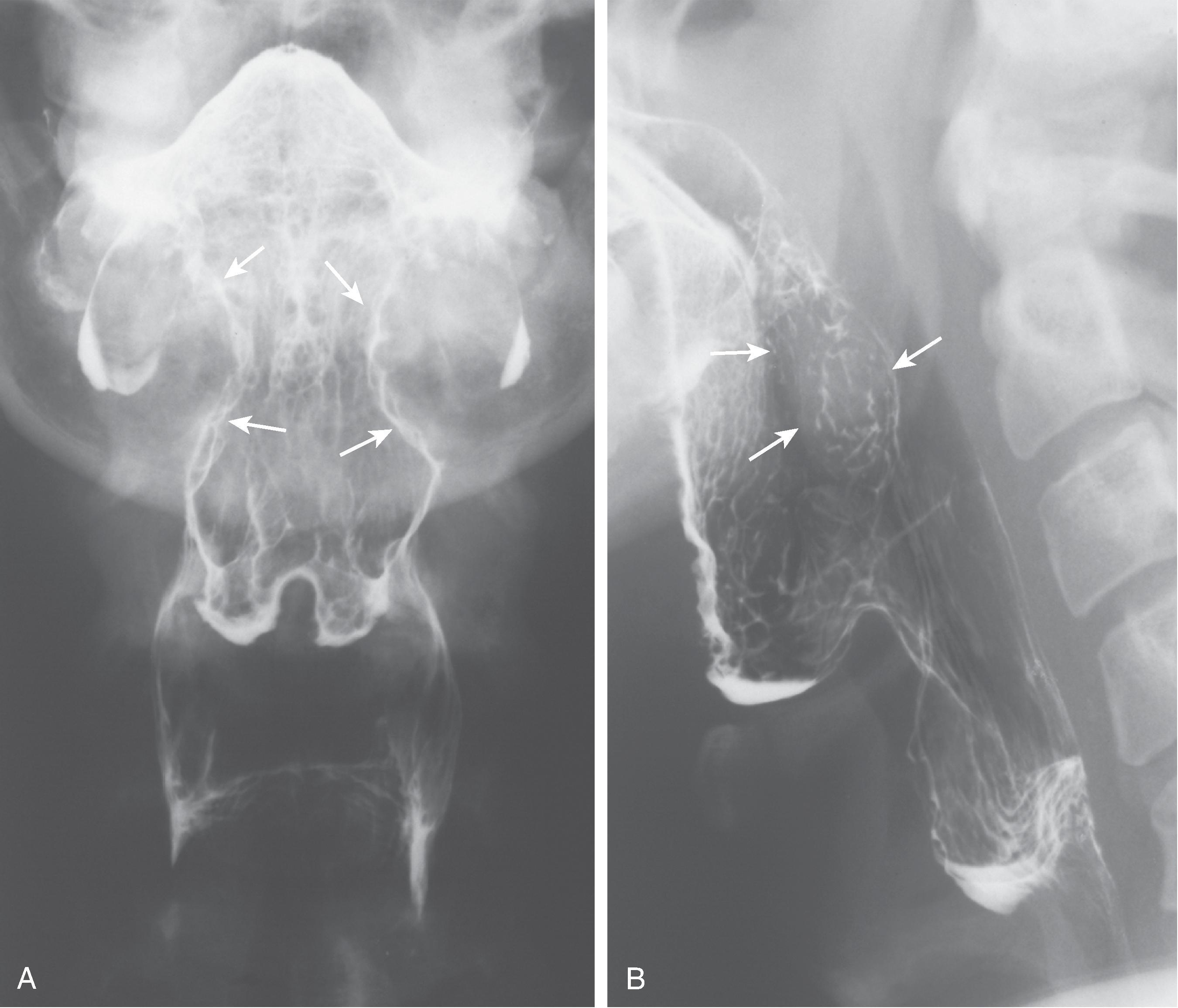
A wide variety of benign tumors involve the pharynx. Nonepithelial tumors arising from the supporting tissues of the pharynx are rare, but tumor-like cysts of various histologic types are not uncommon in the pharynx. The most common benign lesions are retention cysts of the valleculae or aryepiglottic folds.
Symptoms are related primarily to the location and polypoid or sessile nature of the lesion. Patients with benign tumors of the base of the tongue may be asymptomatic or may complain of throat irritation or dysphagia. Aryepiglottic fold nodules or mass lesions may cause dysphonia or respiratory symptoms such as stridor. Tumors of the epiglottis and aryepiglottic folds may also result in coughing or choking because of laryngeal penetration. Rarely, pedunculated lesions (papillomas, lipomas, and fibrovascular polyps) may be coughed up into the mouth or may occlude the larynx, causing asphyxiation and sudden death.
Tumors of various histologic types tend to occur at specific locations in the pharynx. Retention cysts and granular cell tumors are the most common benign tumors of the base of the tongue ( Fig. 5.13 ). Ectopic thyroid tissue and thyroglossal duct cysts may also involve the tongue base, but are rare. The tumor-like lesions that usually involve the aryepiglottic folds are retention cysts and saccular cysts. Retention cysts of the aryepiglottic folds are lined by squamous epithelium and are filled with desquamated squamous debris. In contrast, saccular cysts of the aryepiglottic folds arise from mucus-secreting glands of the appendix of the laryngeal ventricle and are filled with mucoid secretions. True soft tissue tumors of the aryepiglottic folds, such as lipomas, neurofibromas, hamartomas, granular cell tumors, and oncocytomas, are rare. Laryngeal involvement in neurofibromatosis (von Recklinghausen’s disease) is rare and usually involves the region of the arytenoid cartilage and aryepiglottic folds. Benign tumors arising from the minor mucoserous salivary glands usually involve the oropharynx in the region of the soft palate and base of the tongue. Benign cartilaginous tumors involving the pharynx (chondromas) usually arise from the posterior lamina of the cricoid cartilage.
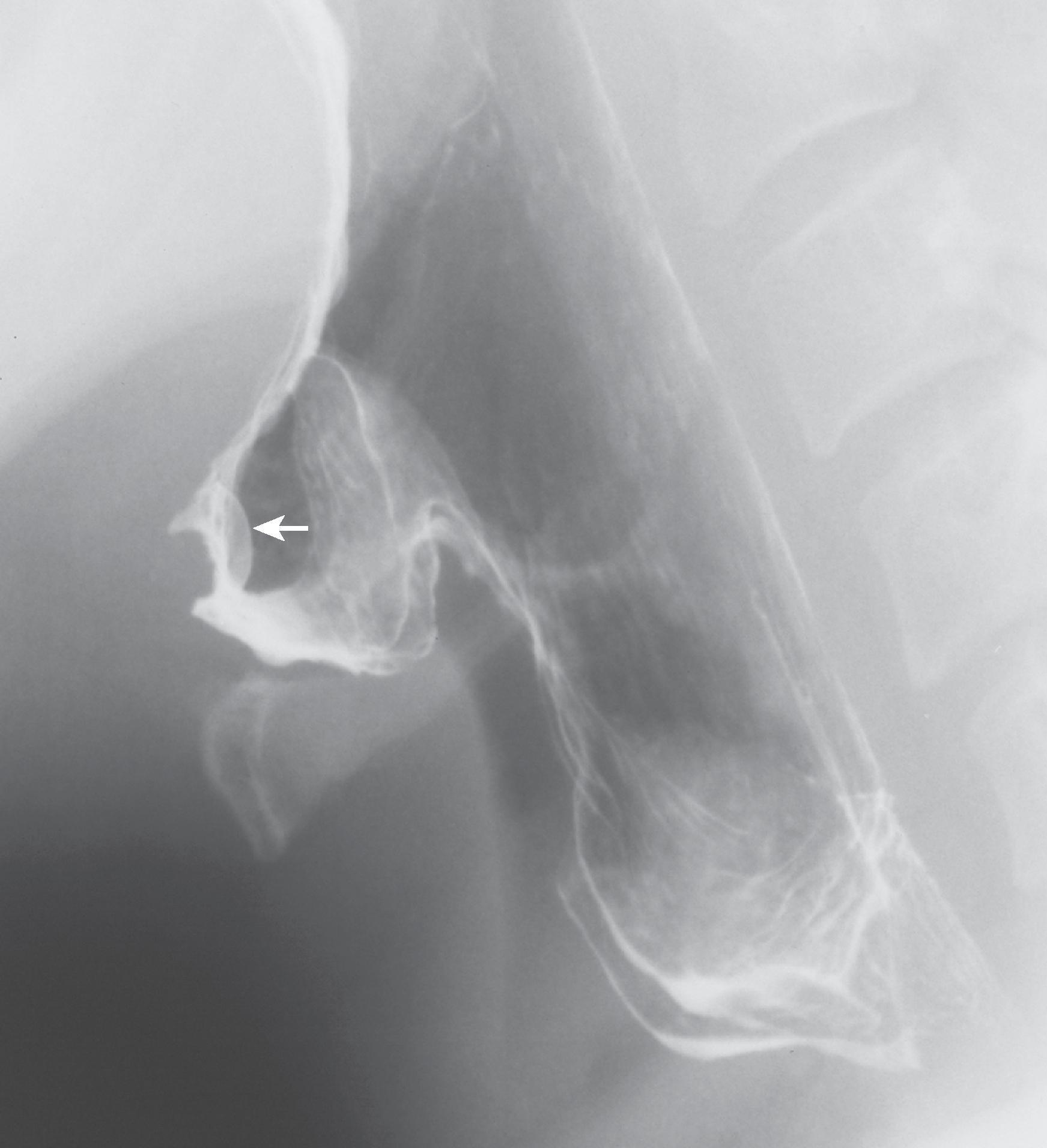
Regardless of its underlying histologic characteristics, a benign pharyngeal tumor usually appears on pharyngograms as a smooth, round, sharply circumscribed mass en face and as a hemispheric line with abrupt angulation in profile. Pedunculated polypoid lesions (papillomas or fibrovascular polyps) are rare. The benign nature of these lesions should be confirmed by endoscopy, though submucosal masses are not always recognized.
The symptoms of pharyngeal carcinoma, including sore throat, dysphagia, and odynophagia, are nonspecific and usually of short duration (<4 months). Choking or coughing may be caused by laryngeal penetration during swallowing or aspiration of liquids trapped in ulcerated tumors. Hoarseness occurs primarily in patients with laryngeal carcinoma, supraglottic carcinoma, or carcinoma of the medial piriform sinus infiltrating the arytenoid cartilage or cricoarytenoid joint. Other tumors cause a referred earache, especially nasopharyngeal tumors that occlude the eustachian tube. Some patients are asymptomatic but present with a palpable neck mass. Most patients with squamous cell carcinoma are 50 to 70 years of age. Almost all patients (>95%) are moderate to heavy abusers of alcohol and tobacco or have tumors related to human papilloma virus.
Become a Clinical Tree membership for Full access and enjoy Unlimited articles
If you are a member. Log in here